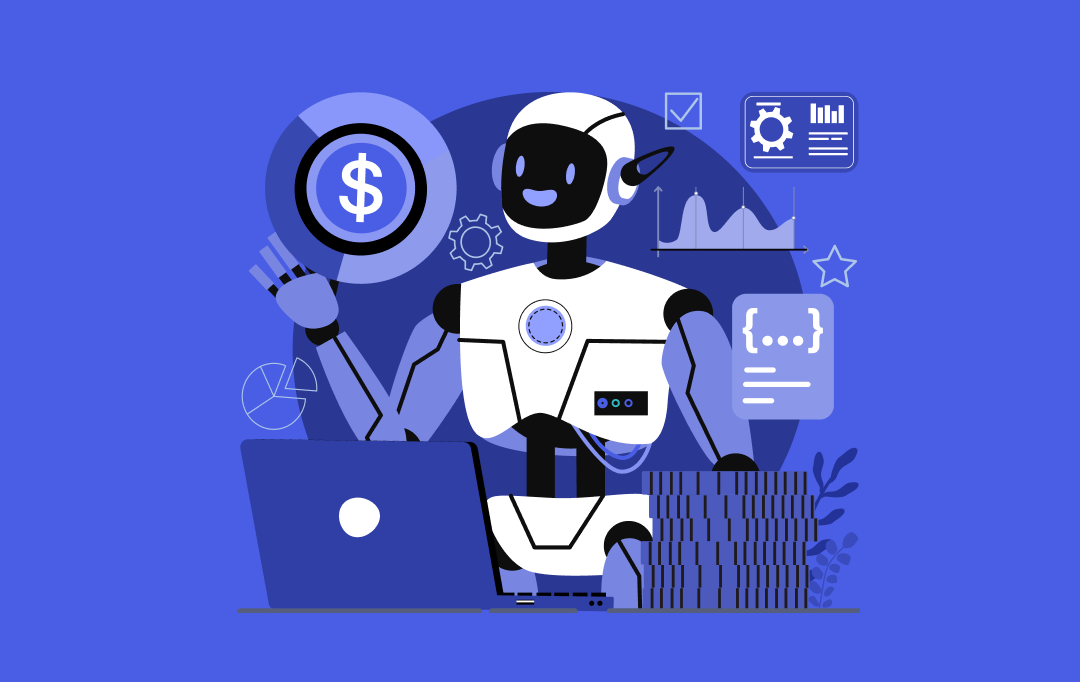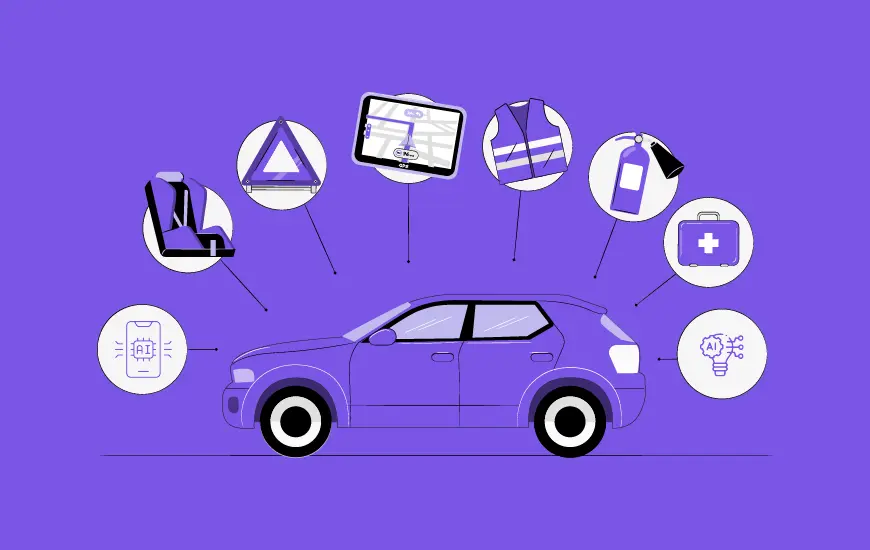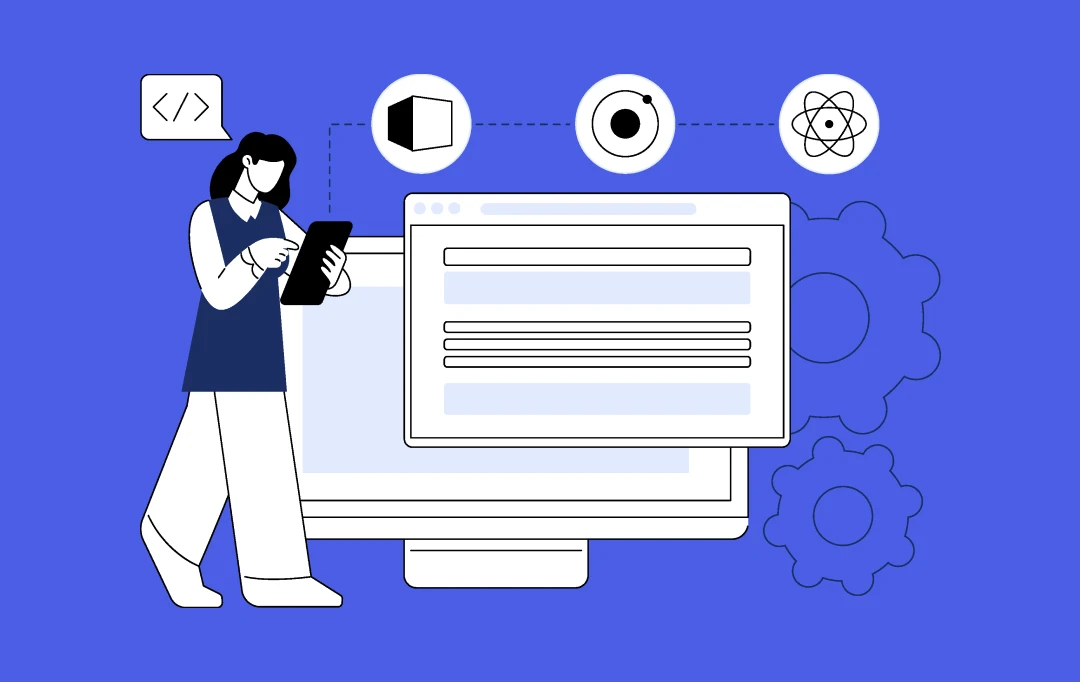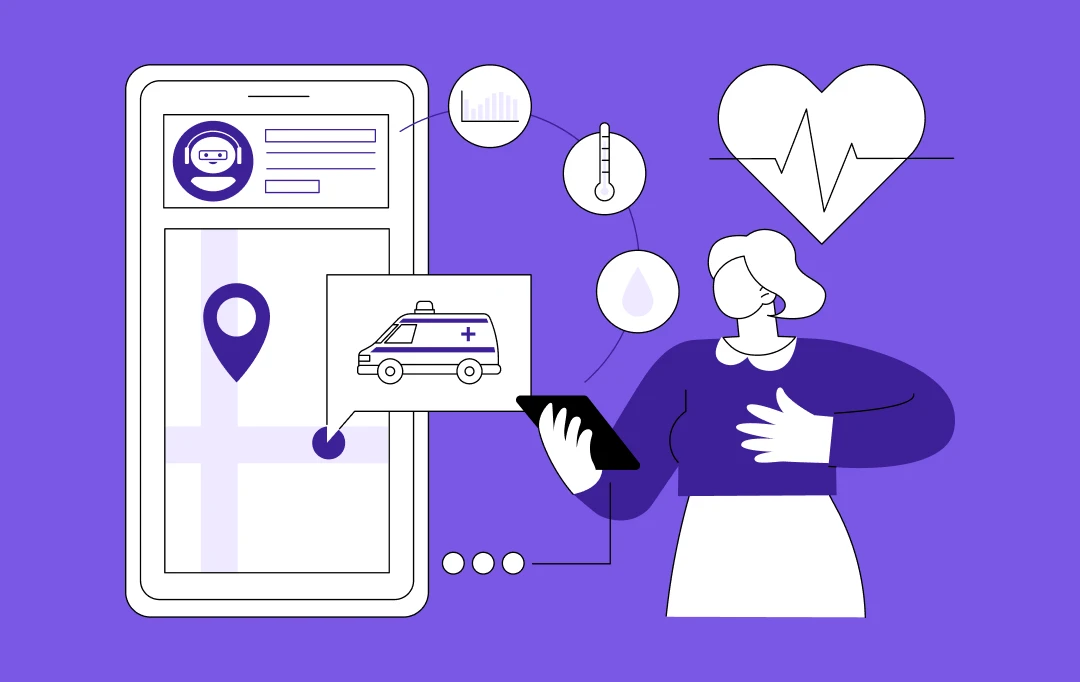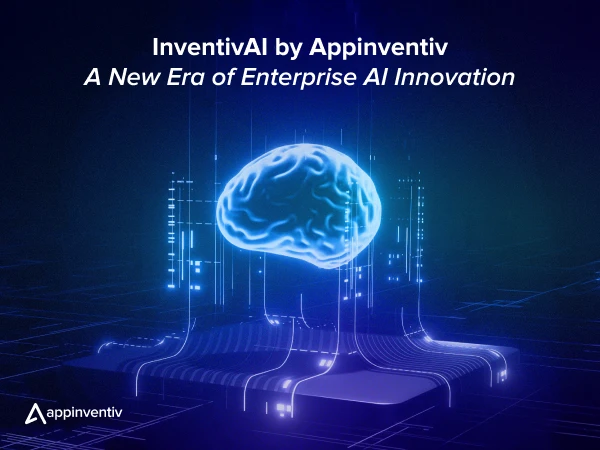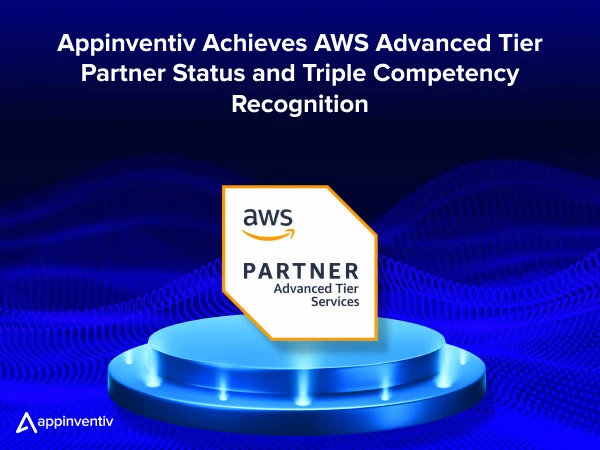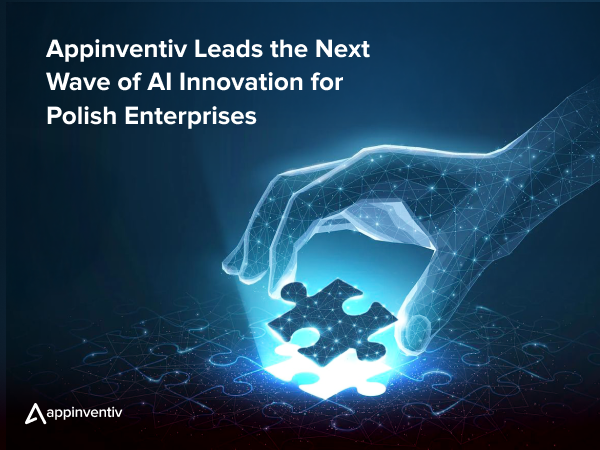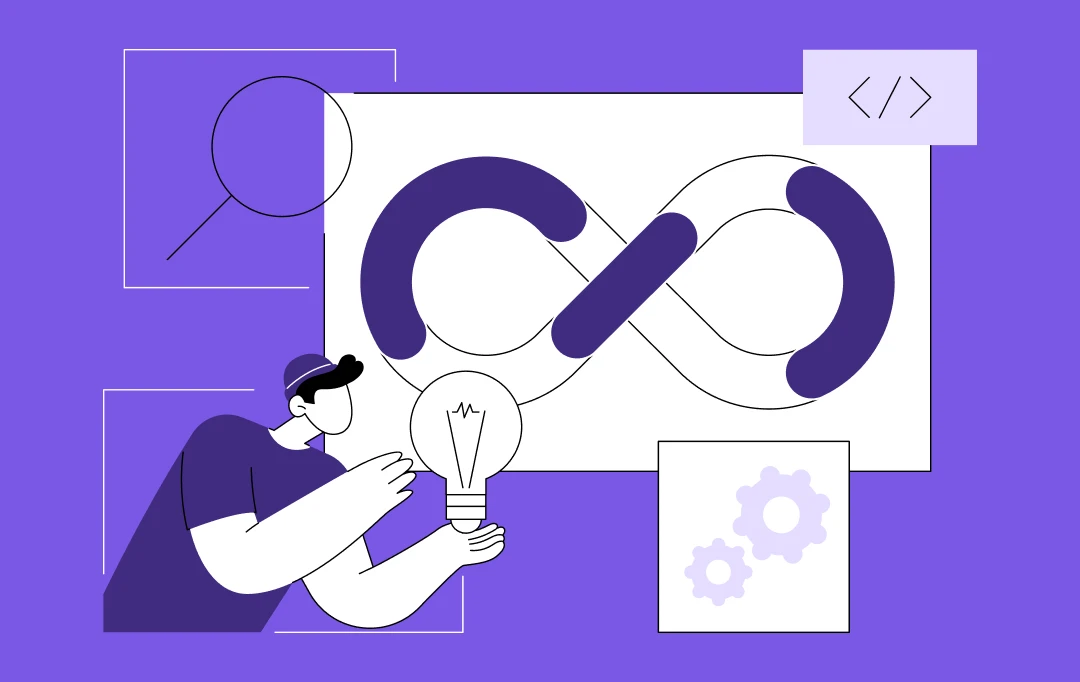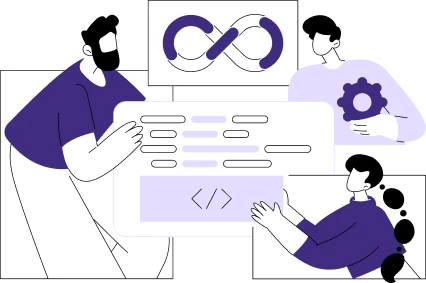- Align Your DevOps Capabilities With Business Outcomes
- Levels of DevOps Maturity Model: From Ad-hoc to AI-Driven Excellence
- Level 1. Initial (Ad-hoc Practices)
- Level 2. Managed (Defined Processes)
- Level 3. Defined (Standardized Toolsets)
- Level 4. Measured (Data-Driven Decisions)
- Level 5. Optimized (AI/ML-Driven Pipelines)
- Key Characteristics of Mature DevOps Organizations
- 1. End-to-End Automation
- 2. Real-Time Visibility and Observability
- 3. Culture of Ownership and Collaboration
- 4. AI-Augmented Pipelines
- 5. Embedded Security (DevSecOps)
- Why DevOps Maturity Must Be a Boardroom Priority?
- 1. Continuous Integration and Continuous Delivery (CI/CD) at Scale
- 2. Infrastructure as Code (IaC) and Automated Provisioning
- 3. Advanced Monitoring and Observability
- 4. DevSecOps: Security Embedded in the Pipeline
- 5. AI/ML-Driven Automation and Predictive Insights
- Actionable Steps to Kickstart and Scale DevOps Maturity
- Secure Executive Sponsorship
- Conduct a Current State Assessment
- Develop a Roadmap with Clear Milestones
- Invest in Training and Enablement
- Promote Cross-Team Collaboration
- Frameworks to Guide Your DevOps Transformation
- The CALMS Model
- DORA Metrics
- DevOps Maturity Models
- Value Stream Mapping (VSM)
- Overcoming Common Challenges in DevOps Maturity
- 1. Cultural Resistance and Strategies to Drive Change
- 2. Managing Toolchain Complexity and Fragmentation
- 3. Addressing Talent Gaps and Upskilling Teams
- 4. Navigating Compliance, Security, and Regulatory Challenges
- 5. Balancing Speed and Stability in Large-Scale Environments
- Technologies and Practices That Enable DevOps Maturity
- Infrastructure as Code (IaC)
- Containerization and Kubernetes
- Microservices Architecture
- Observability and AIOps
- Security as Code (DevSecOps)
- The Future of DevOps Maturity: A Gateway to Agile Innovation and Sustainable Growth
- AI-Driven Automation and Predictive Capabilities
- GitOps and Declarative Infrastructure
- Platform Engineering and Developer Experience
- Edge Computing and Cloud-Native Technologies
- Increased Focus on Sustainability and Cost Optimization
- Accelerate Your Maturity Journey With Appinventiv: Why We Are Your Ideal DevOps Partner
- FAQs
Key takeaways:
- DevOps maturity is a business growth driver—not just a tech upgrade.
- Organizations evolve through five stages, from ad-hoc practices to AI-driven automation.
- Mature DevOps teams excel in automation, collaboration, observability, and security.
- Strategic frameworks like CALMS, DORA, and VSM guide transformation effectively.
- Achieving maturity requires cultural shifts, skilled teams, and continuous measurement.
The days of treating DevOps as a “nice-to-have” are long gone. In 2025, a clear divide has emerged between organizations that have achieved DevOps maturity and those still struggling to bridge the gap.
Across industries, leaders are already reaping the benefits. According to a recent study by Boston Consulting Group, companies that have developed advanced AI capabilities, often enabled by the DevOps maturity model, are achieving 1.5 times higher revenue growth and 1.6 times greater shareholder returns compared to their peers. These leaders focus on integrating AI into core business processes, a feat made possible through robust DevOps frameworks and clearly defined DevOps capability models.
But here’s the game: while many organizations initiate DevOps transformations, few achieve true maturity. A significant number struggle with fragmented toolchains, cultural resistance, and a lack of automation. For instance, a study evaluating DevSecOps adoption among SMEs found that while 68% had implemented DevSecOps, only 12% conducted security scans per commit, highlighting gaps in automation and a lack of complete alignment with the DevOps maturity model stages.
This blog is your strategic guide to understanding DevOps maturity—not just as a technical milestone, but as a business imperative. We’ll explore:
- What DevOps maturity looks like in 2025: From initial adoption to optimized, AI-driven pipelines.
- Why it matters to the C-suite: Linking DevOps maturity to business outcomes like revenue growth, operational efficiency, and competitive advantage.
- How to achieve it: Practical steps for CEOs and CTOs to lead their organizations toward DevOps excellence.
By the end, you’ll have a clear roadmap to elevate your organization’s DevOps practices, ensuring you’re not just keeping pace but setting the standard in your industry using a well-structured DevOps maturity model checklist.
Build a strong DevOps foundation with us.
Align Your DevOps Capabilities With Business Outcomes
DevOps maturity isn’t just about deploying faster—it’s about aligning your engineering capabilities with strategic business outcomes. At its core, DevOps maturity reflects how deeply DevOps principles are embedded in your people, processes, and technology stack.
Organizations that consistently benchmark themselves using DevOps benchmarking tools and a reliable DevOps maturity model framework gain better insights and stay ahead of the curve. For accurate benchmarking, many enterprises rely on a devops maturity assessment model to identify actionable gaps and prioritize investments.
[Also Read: Unlocking Synergies and Efficiency by Harnessing DevOps for Business]
Think of it like a performance engine. The more mature your DevOps, the more predictable, scalable, and secure your product delivery becomes. Mature organizations don’t just “do DevOps”; they live it through automation, observability, continuous learning, and a strong feedback culture across the organization.
According to the 2024 DORA State of DevOps Report, only 19% of organizations have achieved elite DevOps performance, characterized by rapid delivery, low failure rates, and fast recovery times. This highlights the significant gap between initial adoption and true optimization, where many companies still face challenges in scaling their DevOps practices effectively—a reminder of the importance of following a comprehensive agile DevOps maturity model.

That’s exactly why businesses need a clear understanding of where they are today—and where they need to go.
With this foundational understanding, let’s explore the stages organizations typically progress through on their DevOps maturity journey. Understanding your current devops maturity levels provides the clarity needed to chart a focused and outcome-driven DevOps transformation strategy.
Levels of DevOps Maturity Model: From Ad-hoc to AI-Driven Excellence
Understanding your organization’s current DevOps maturity stage is key to targeting improvements that drive real business impact. Here’s a practical breakdown of the typical phases of DevOps maturity, highlighting what happens at each stage and why it matters to leadership.
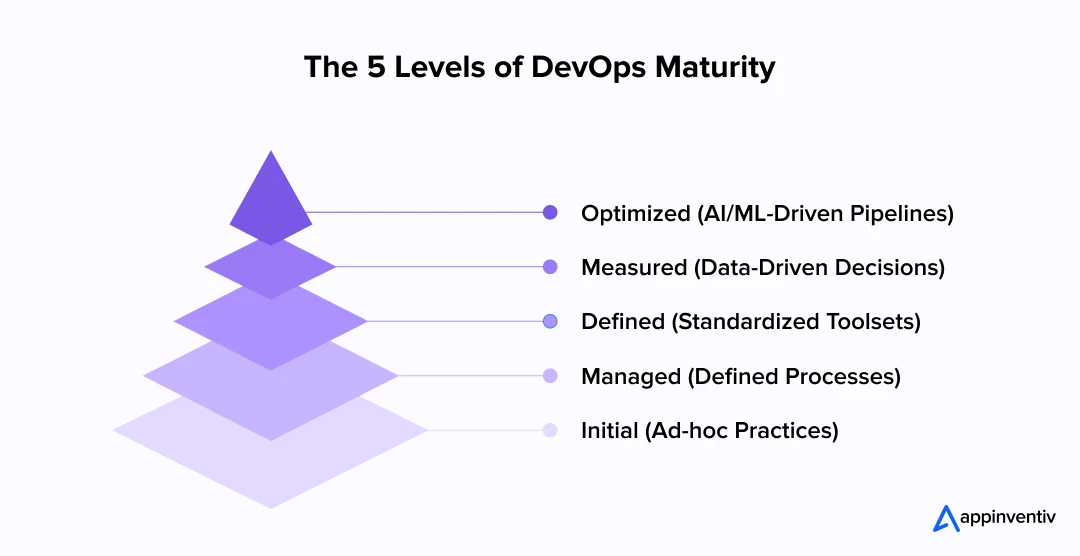
Level 1. Initial (Ad-hoc Practices)
At this starting point, Dev and Ops teams work in silos with manual, inconsistent deployments and limited automation. Issues such as downtime and deployment failures are common, and troubleshooting is often reactive and slow.
- Impact: Low product velocity, high risk, and frustrated teams struggling to keep up with demands.
- Leadership Insight: Urgent need for foundational processes and culture change to prevent costly delays and talent loss.
Level 2. Managed (Defined Processes)
Basic workflows and version control are established, and some CI/CD pipelines may exist, but efforts remain isolated across teams. Cross-team collaboration is limited, and automation covers only parts of the delivery process.
- Impact: More reliable releases, but scaling challenges persist and overall delivery speed is still inconsistent.
- Leadership Insight: Focus on integrating teams and expanding automation to improve predictability and reduce bottlenecks.
Level 3. Defined (Standardized Toolsets)
The organization adopts consistent tools and standardized workflows across teams, with automated testing and Infrastructure as Code becoming the norm. Environments are stable and reproducible.
- Impact: Improved engineering efficiency, faster onboarding, and higher software quality.
- Leadership Insight: This stage enables scaling innovation—invest in training and tooling to maximize these gains.
Level 4. Measured (Data-Driven Decisions)
In this stage of DevOps maturity model, key performance metrics like lead time and failure rates guide continuous improvement. Monitoring and observability provide real-time insights, enabling proactive incident management and faster recovery.
- Impact: DevOps becomes a measurable driver of business outcomes, with risk substantially reduced.
- Leadership Insight: Align engineering metrics with business goals and foster a culture of accountability and transparency.
Level 5. Optimized (AI/ML-Driven Pipelines)
AI-powered automation predicts failures, optimizes workflows, and supports self-service platforms for developers. Continuous delivery is seamless, secure, and scalable.
- Impact: Engineering is a strategic competitive advantage that accelerates innovation with minimal risk.
- Leadership Insight: Focus on sustaining innovation, scaling platforms, and maintaining governance without slowing agility.
[Also Read: AI in DevOps: Revolutionizing Software Development and Operations]
These phases of DevOps maturity represent a meaningful step toward transforming your engineering function from a bottleneck into a growth engine. Knowing where you stand helps you invest smartly and lead the change toward true DevOps maturity.
Having walked through the multiple levels of DevOps maturity, it’s essential to understand what truly differentiates mature DevOps organizations from the rest. Let’s dig deeper into their defining characteristics.
Key Characteristics of Mature DevOps Organizations
Mature DevOps organizations are not just faster or more automated; they exhibit a distinct set of traits that transform how technology fuels business growth. Here’s what sets them apart in detail:

1. End-to-End Automation
Automation isn’t limited to just building or deploying code—it spans the entire software lifecycle. This means infrastructure provisioning via Infrastructure as Code (IaC), automated security scans integrated into the pipeline (DevSecOps), continuous testing, and even automated incident response.
DevOps automation reduces human error, accelerates releases, and frees engineers to focus on innovation rather than repetitive tasks. For leadership, this means predictable delivery schedules and less firefighting.
2. Real-Time Visibility and Observability
Mature DevOps teams invest heavily in observability tools that provide real-time insights across applications, infrastructure, and user experiences. This unified telemetry allows teams to detect anomalies early, understand root causes quickly, and make proactive decisions.
This visibility translates directly to improved uptime and customer satisfaction, crucial metrics businesses care about.
3. Culture of Ownership and Collaboration
A hallmark of maturity is when developers, QA, and operations teams own the software end-to-end—from development to deployment to monitoring and support. Silos break down, replaced by cross-functional teams aligned on business outcomes.
This culture fosters faster feedback loops, higher quality releases, and better alignment with product goals.
4. AI-Augmented Pipelines
The newest wave of mature DevOps organizations uses AI and machine learning to optimize workflows—whether it’s predictive analytics to forecast build failures, chatbots assisting in incident management, or automated capacity planning.
This integration of AI in DevOps maturity model accelerates innovation cycles and reduces operational overhead.
5. Embedded Security (DevSecOps)
Security is baked in from the start, with automated vulnerability scanning, policy enforcement, and compliance monitoring integrated into the DevOps pipeline. This “shift-left” security approach minimizes risks without slowing down development velocity.
Now that we’ve explored what DevOps maturity looks like and the traits of mature organizations, it’s clear this isn’t just an IT topic—it’s a strategic business imperative. Let’s dive into why achieving DevOps maturity must be a top priority in the boardroom.
Why DevOps Maturity Must Be a Boardroom Priority?
DevOps maturity directly impacts how quickly and reliably your organization can deliver value to customers. For businesses, it’s no longer enough to see DevOps as a technical initiative—it’s a key driver of competitive advantage, operational resilience, and business growth. Here are the main use cases that can help businesses understand the benefits of a DevOps maturity model thoughtfully:
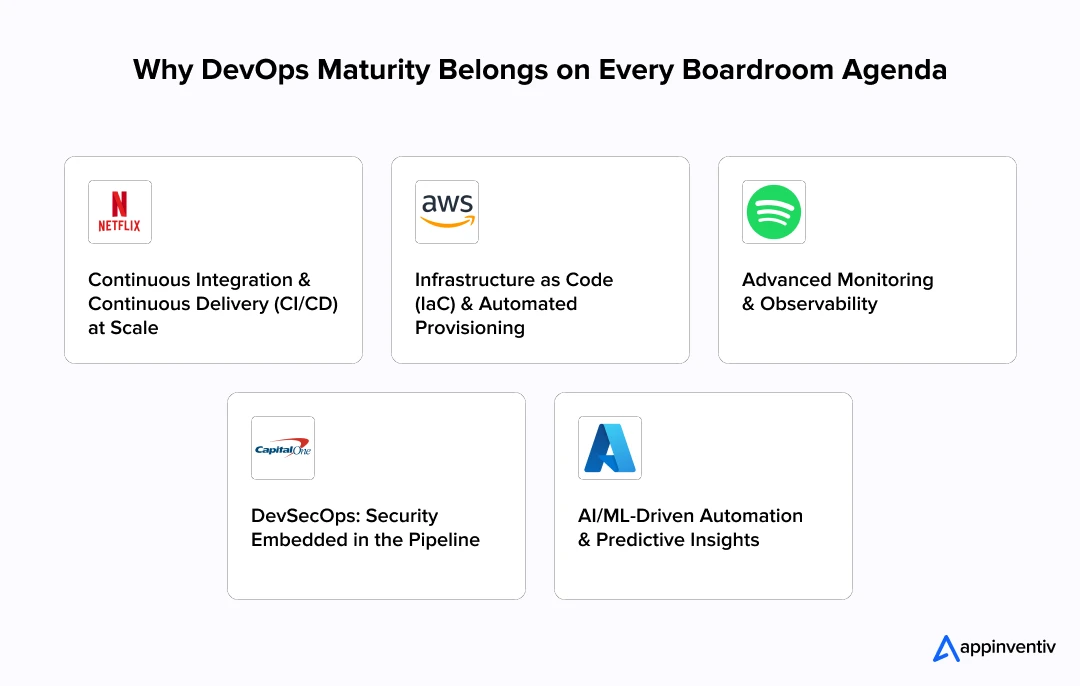
1. Continuous Integration and Continuous Delivery (CI/CD) at Scale
Mature DevOps enables fully automated build, test, and deployment pipelines that support multiple releases per day without sacrificing quality. This requires tight integration between development, testing, and operations teams, with real-time feedback loops that catch errors early and reduce deployment risks.
Real-World Example: Netflix
Netflix uses sophisticated CI/CD practices to support frequent deployments across its global microservices infrastructure. This speed and reliability allow Netflix to continuously innovate its streaming platform, personalize user experiences, and roll out features with minimal downtime.
2. Infrastructure as Code (IaC) and Automated Provisioning
IaC allows organizations to manage and provision infrastructure using code, making environments reproducible, version-controlled, and scalable. This reduces configuration drift and accelerates environment setup, enabling developers to spin up or tear down environments rapidly with minimal manual intervention.
Real-World Example: Amazon Web Services (AWS)
AWS extensively uses IaC tools like AWS CloudFormation and Terraform to automate infrastructure deployment at scale. This approach helps AWS maintain the flexibility and scalability required for its cloud offerings while ensuring consistency and compliance.
3. Advanced Monitoring and Observability
Mature DevOps integrates comprehensive monitoring and observability across applications and infrastructure. This goes beyond traditional alerts, enabling teams to understand system behavior, pinpoint root causes, and anticipate issues before customers are impacted.
Real-World Example: Spotify
Spotify enhances observability through advanced monitoring practices and internal tools like Backstage to manage its microservices ecosystem. Their ability to detect and respond to anomalies quickly has been crucial in maintaining seamless music streaming experiences for millions of users worldwide.
[Also Read: How Much Does it Cost to Develop a Music Streaming App Like Spotify]
4. DevSecOps: Security Embedded in the Pipeline
Embedding security into every phase of the DevOps lifecycle ensures vulnerabilities are detected early, compliance is automated, and security doesn’t slow down development. Mature DevSecOps practices combine automated security scanning, policy enforcement, and continuous compliance auditing.
Real-World Example: Capital One
Capital One has embraced DevSecOps to automate security testing and compliance in its cloud infrastructure and applications. This has enabled faster innovation cycles while meeting stringent regulatory requirements in the financial sector.
5. AI/ML-Driven Automation and Predictive Insights
Leading organizations are leveraging AI and machine learning within their DevOps pipelines to predict failures, optimize resource allocation, and automate remediation. This transforms DevOps from a reactive to a proactive approach, reducing downtime and enhancing system resilience.
Real-World Example: Microsoft Azure
Microsoft Azure utilizes AI-powered tools, such as Azure Monitor and Application Insights, to analyze telemetry data and predict potential system issues. This enables their teams to proactively address issues, thereby enhancing the reliability of their cloud platform for millions of customers.
The use cases we’ve explored demonstrate how DevOps maturity tangibly drives innovation, resilience, and growth across industries. But understanding these capabilities is only half the battle. The real opportunity for businesses lies in translating this knowledge into practical, high-impact actions that accelerate their organization’s DevOps journey.
Actionable Steps to Kickstart and Scale DevOps Maturity
The journey toward DevOps maturity begins with deliberate, well-planned moves that leadership can champion immediately. Each step is essential to build momentum, secure buy-in, and create a culture and environment where DevOps principles can flourish.
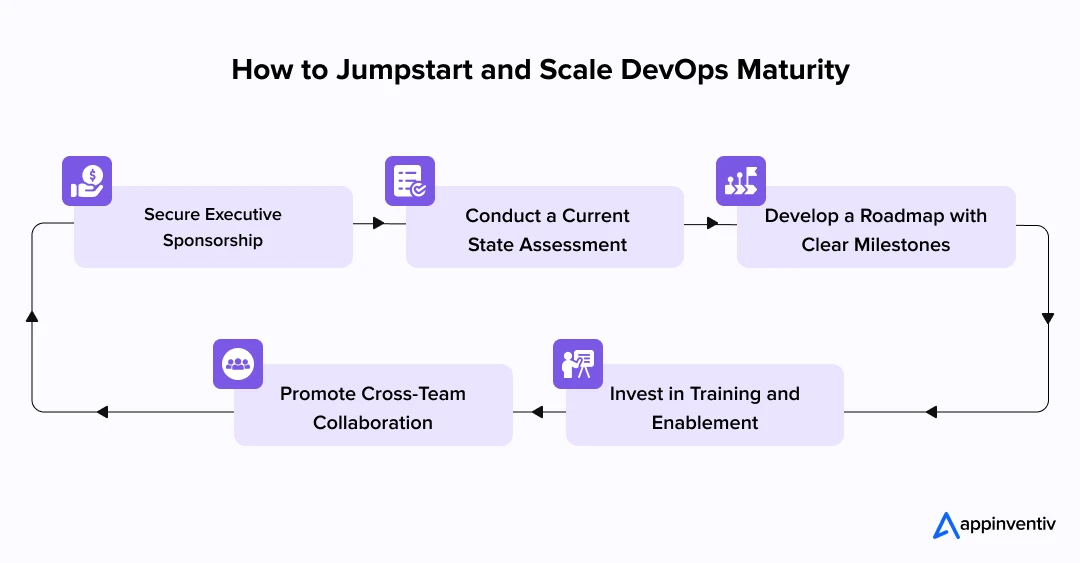
Secure Executive Sponsorship
DevOps maturity is as much about culture and organizational change as it is about technology. Without committed support from the C-suite, efforts often stall due to a lack of resources or conflicting priorities. When businesses actively endorse DevOps initiatives, it sends a powerful message across all departments that this transformation is a top business priority.
Executive sponsorship also helps break down resistance by aligning DevOps goals with broader business objectives, such as faster time-to-market, enhanced customer experience, and risk reduction. It enables investment in necessary tools, training, and cross-team collaboration initiatives.
Conduct a Current State Assessment
Before charting a path forward, leaders must have a clear, honest understanding of where their organization stands today. Conducting a thorough DevOps maturity assessment helps identify strengths, weaknesses, and critical gaps—whether in culture, process, technology, or security.
This assessment can leverage maturity models, team interviews, and tooling audits to create a baseline. Knowing your starting point allows prioritization of initiatives that deliver the highest impact first and prevents wasted effort on “nice-to-haves” that don’t align with immediate business needs.
Develop a Roadmap with Clear Milestones
Transformation without a plan is chaos. A practical, phased roadmap breaks the journey into manageable chunks, with defined milestones and measurable outcomes. This roadmap should strike a balance between quick wins, such as automating a key deployment pipeline or standardizing environment provisioning, and longer-term goals, including embedding AI-driven automation and creating internal developer platforms.
A DevOps maturity model checklist can help guide this roadmap, ensuring all critical dimensions are addressed at each stage. Setting clear milestones keeps teams motivated and leadership informed, creating transparency around progress and enabling course corrections when needed.
Invest in Training and Enablement
Tools and processes are only as good as the people using them. Empowering your engineering and operations teams with the right skills and knowledge is essential. This includes training on new automation tools, security best practices, infrastructure as code, and collaborative workflows.
Beyond formal training, creating communities of practice and encouraging knowledge sharing fosters continuous learning, making your DevOps culture more resilient and adaptable.
Promote Cross-Team Collaboration
DevOps thrives on breaking down silos. Encouraging regular communication, joint problem-solving, and shared ownership across development, operations, security, and quality assurance teams accelerates feedback loops and improves overall delivery quality.
Leadership should model and reward collaboration, creating an environment where teams feel accountable not just for their piece but for the entire software lifecycle. By focusing on these steps, you build momentum and create a sustainable path toward maturity. Let’s now look at frameworks that help structure and guide this complex transformation.
Align culture, tools, and automation for secure, efficient growth. Partner with us to unlock lasting software value.
Frameworks to Guide Your DevOps Transformation
Successfully navigating the complexities of DevOps maturity requires more than good intentions—it demands structured guidance. Let’s examine the frameworks that provide proven blueprints, reducing guesswork, aligning diverse teams, and enabling leadership to focus resources on high-impact areas.
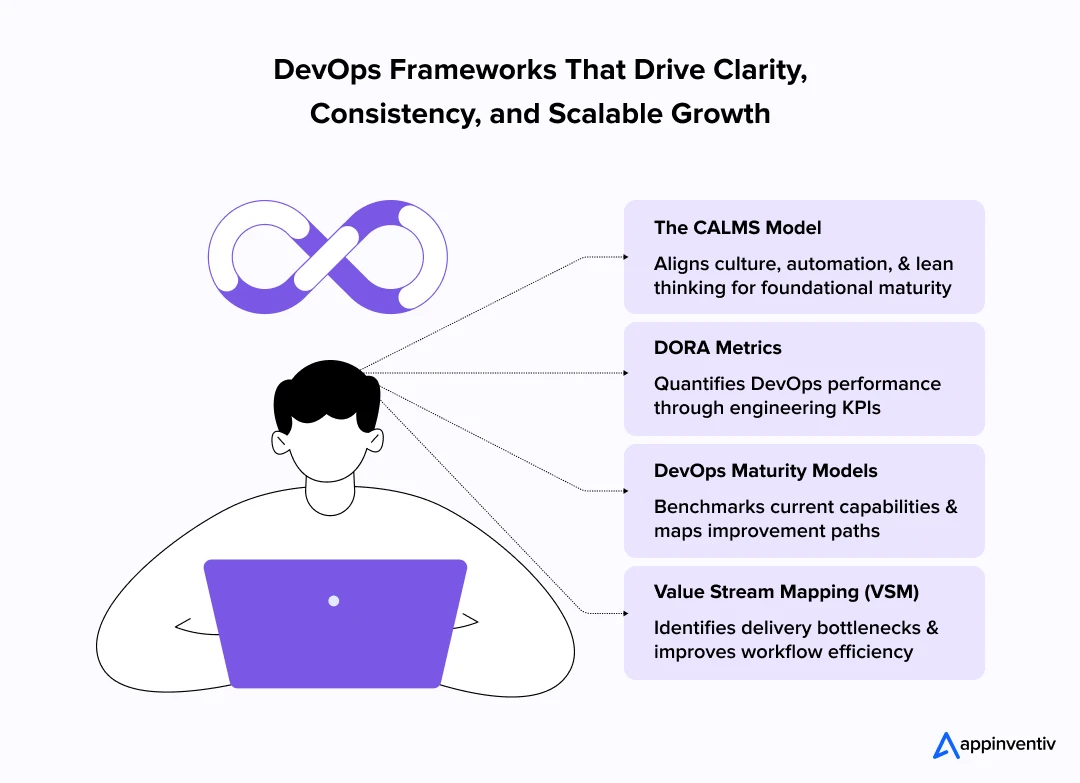
The CALMS Model
It emphasizes five critical dimensions: Culture, Automation, Lean principles, Measurement, and Sharing. It reminds us that DevOps success depends as much on fostering collaborative culture and continuous learning as on adopting automation tools. For leaders, this means investing in both people and technology to drive sustainable change.
Best suited for: Initial to Defined stages—establishes cultural and process alignment early in the journey.
DORA Metrics
They focus on four key indicators—Deployment Frequency, Lead Time for Changes, Mean Time to Recovery (MTTR), and Change Failure Rate—to objectively measure DevOps performance. Regularly tracking these metrics enables leadership to pinpoint bottlenecks, improve reliability, and tie technical improvements to tangible business outcomes.
Best suited for: Measured and Optimized stages—used to refine and link engineering efforts with business outcomes continuously.
DevOps Maturity Models
DevOps Maturity Models, such as those developed by Gartner and Forrester, provide staged frameworks to assess an organization’s current state and define targeted steps for progression. A DevOps maturity model for enterprises ensures that larger organizations can scale DevOps practices while aligning them with business outcomes and governance standards.
Best suited for: Managed to Measured stages—ideal for benchmarking and identifying targeted improvement areas.
Value Stream Mapping (VSM)
It visualizes the entire software delivery lifecycle, helping identify inefficiencies and delays in workflows. By revealing handoffs and bottlenecks, VSM empowers teams to streamline processes, accelerate delivery, and maximize value flow from development through to production.
Best suited for: Defined to Optimized stages—helps in streamlining and scaling delivery across complex environments.
Together, these frameworks offer a comprehensive toolkit for business leaders to lead their DevOps transformation with focus and confidence, ensuring that every step taken drives measurable progress toward true maturity.
With solid frameworks providing the structure and measurement tools to guide your DevOps journey, the next critical piece is adopting best practices that create a culture and environment where DevOps can truly thrive and evolve.
Overcoming Common Challenges in DevOps Maturity
DevOps maturity requires not only technical changes but also cultural shifts, skill development, and process reengineering. Many organizations struggle with a range of hurdles during the implementation of the Agile DevOps maturity model , which can slow or derail their progress if left unaddressed. Understanding these challenges and applying effective solutions is critical for businesses to lead their teams confidently through transformation.

1. Cultural Resistance and Strategies to Drive Change
Challenge: Many organizations face pushback from teams accustomed to traditional silos and legacy processes. Resistance to adopting the DevOps maturity model can stem from a fear of change, a lack of trust, or unclear communication about the benefits of DevOps.
Solution: Drive cultural change through transparent leadership communication, showcasing quick wins to build trust. Encourage collaboration by breaking down silos with cross-functional teams and promoting a safe environment for experimentation and learning.
2. Managing Toolchain Complexity and Fragmentation
Challenge: Fragmented and incompatible tools across teams lead to integration issues, inefficiencies, and increased overhead, hindering seamless automation and workflow consistency.
Solution: Standardize and consolidate your toolchain around interoperable platforms that support your CI/CD, monitoring, and security needs. Prioritize tools that integrate well and allow scalability, reducing complexity and easing maintenance.
3. Addressing Talent Gaps and Upskilling Teams
Challenge: Rapid technological evolution often creates skill gaps, leaving teams unprepared to implement advanced automation, security, and cloud-native practices effectively.
Solution: Invest in ongoing training programs, certifications, and mentorship. Foster a learning culture by encouraging knowledge sharing, experimentation, and attendance at industry conferences or workshops to keep skills current.
4. Navigating Compliance, Security, and Regulatory Challenges
Challenge: Strict compliance and security requirements can slow down deployments and complicate automation efforts, particularly in regulated industries such as finance or healthcare.
Solution: Embed security early in the development lifecycle through DevSecOps practices. Automate compliance checks and audits as part of your CI/CD pipelines to maintain speed without compromising on regulatory standards.
5. Balancing Speed and Stability in Large-Scale Environments
Challenge: Scaling DevOps practices across multiple teams and geographies can introduce complexity, which risks stability when rapid releases increase the likelihood of failures.
Solution: Implement robust monitoring, automated testing, and gradual rollout strategies such as canary deployments and feature flags. Build internal developer platforms that enable self-service with governance controls to maintain quality at scale.
Technologies and Practices That Enable DevOps Maturity
Mature DevOps organizations leverage a set of foundational technologies and practices to automate, scale, and secure their software delivery pipelines. Here are some of the most impactful:
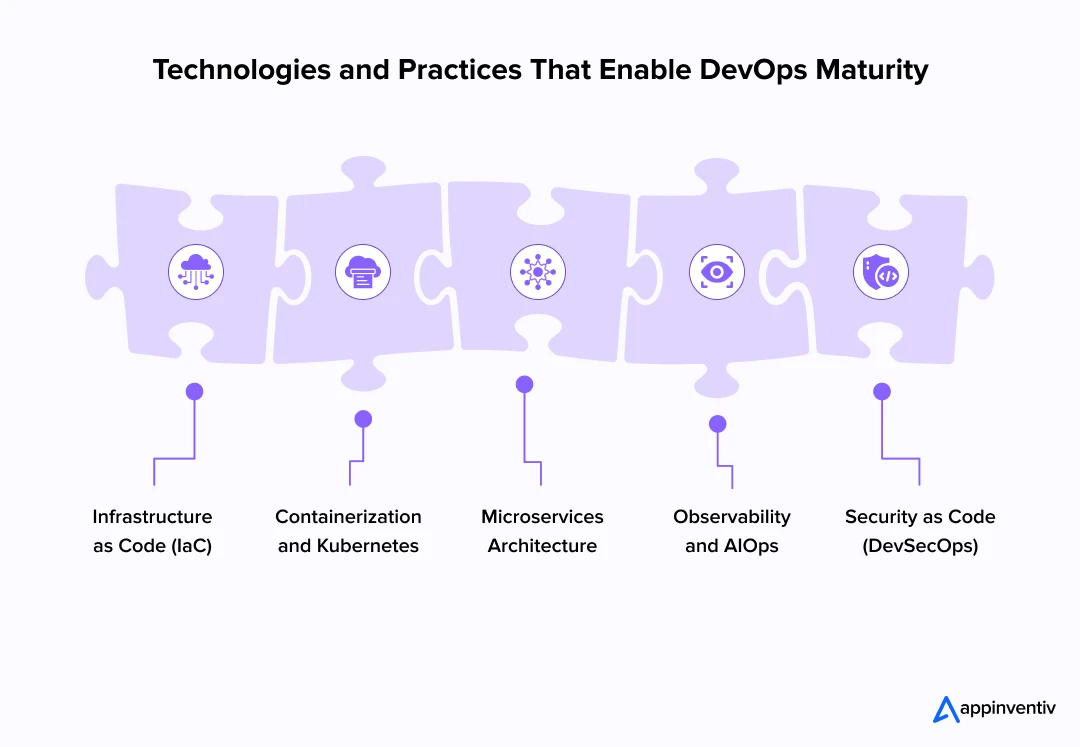
Infrastructure as Code (IaC)
IaC transforms infrastructure management from manual configuration to automated, version-controlled code. This approach ensures environments are consistent, reproducible, and scalable, reducing configuration drift and speeding up provisioning.
Containerization and Kubernetes
Containers package applications with their dependencies, ensuring consistency across environments. Kubernetes orchestrates container deployment and scaling, enabling resilient, automated management of complex distributed applications.
Microservices Architecture
Breaking applications into loosely coupled, independently deployable services increases agility. Microservices allow teams to develop, test, and deploy components separately, improving scalability and fault isolation.
Observability and AIOps
Beyond traditional monitoring, observability provides deep insights into application performance and behavior. AIOps leverages AI and machine learning to analyze this data, detect anomalies, predict incidents, and automate remediation.
Security as Code (DevSecOps)
Embedding security checks and policies directly into development and deployment pipelines ensures vulnerabilities are detected early. This approach maintains speed while enforcing compliance and reducing risks.
The Future of DevOps Maturity: A Gateway to Agile Innovation and Sustainable Growth
The DevOps landscape is rapidly advancing. Here’s what business leaders should watch for as they plan for the future:
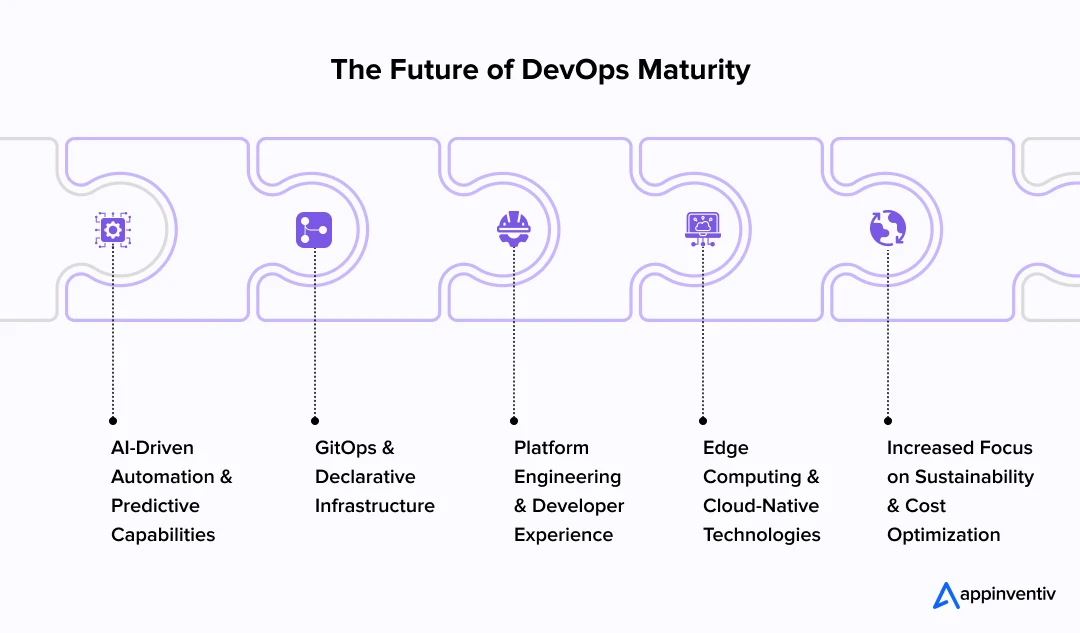
AI-Driven Automation and Predictive Capabilities
AI will increasingly power predictive analytics for failure prevention, automated root cause analysis, and intelligent resource allocation, making pipelines more resilient and self-healing.
GitOps and Declarative Infrastructure
GitOps, which uses Git as the single source of truth for infrastructure and application deployment, will streamline operations and improve auditability, making infrastructure changes safer and more transparent.
Platform Engineering and Developer Experience
Internal developer platforms (IDPs) will become standard, providing self-service capabilities that empower developers while ensuring governance and standardization, accelerating delivery without sacrificing control.
Edge Computing and Cloud-Native Technologies
As applications increasingly run on distributed edge environments, DevOps practices will evolve to manage decentralized infrastructures securely and efficiently.
Increased Focus on Sustainability and Cost Optimization
Future DevOps strategies will incorporate environmental and cost factors, optimizing resource usage to strike a balance between performance, reliability, and sustainability.
Accelerate Your Maturity Journey With Appinventiv: Why We Are Your Ideal DevOps Partner
We hope this blog has helped you gain a clear understanding of what the DevOps maturity model signifies, why it’s critical for your business, and how you can lead your organization toward achieving it. Whether you’re a startup or a global corporation, adopting a DevOps maturity model for enterprises provides a structured path to scale DevOps capabilities in complex environments.
Now, the path to mature DevOps practices may seem complex, but with the right partner, it becomes a strategic advantage rather than a challenge.
As a leading DevOps services and solutions firm, we specialize in guiding enterprises through every stage of their DevOps transformation. Our team combines deep technical expertise with proven methodologies to design, implement, and scale DevOps frameworks that align perfectly with your business goals. From automating pipelines and integrating security to fostering a culture of collaboration, we tailor solutions that drive measurable impact.
What sets us apart is our commitment to innovation and client success. We leverage the latest technologies—including AI-driven automation, advanced monitoring, and cloud-native architectures—to ensure your DevOps practices not only mature but also future-proof your software delivery. Our certified experts work as an extension of your team, providing ongoing support and continuous improvement to keep you ahead of the curve.
Partnering with Appinventiv means accelerating your DevOps maturity journey with confidence. Let us help you transform your engineering capabilities into a powerful engine of growth, resilience, and innovation. Reach out today to discover how we can empower your organization to lead in the fast-evolving digital landscape.
FAQs
Q. How to measure DevOps maturity?
A. DevOps maturity model assessment involves assessing how well your organization integrates people, processes, and technology to deliver software efficiently and reliably. One of the most effective ways to do this is by aligning your efforts with clearly defined DevOps evaluation criteria. Common methods include:
- Conducting maturity assessments based on established models (e.g., Gartner, DORA, CALMS) or using a tailored devops maturity assessment model helps businesses gain a detailed view of their current capabilities.
- Tracking key performance metrics like deployment frequency, lead time, change failure rate, and mean time to recovery (DORA metrics).
- Evaluating automation levels across CI/CD, testing, and infrastructure management.
- Reviewing cultural factors such as collaboration, ownership, and continuous learning.
- Mapping value streams to identify bottlenecks and inefficiencies.
Q. How does DevOps maturity impact security (DevSecOps)?
A. Higher DevOps maturity integrates security seamlessly into development pipelines, transforming security from a bottleneck into an enabler. Key impacts include:
- Early detection of vulnerabilities through automated security scans.
- Continuous compliance monitoring embedded in workflows.
- Faster remediation of security issues with automated alerts and fixes.
- Shared responsibility between development, operations, and security teams.
- Reduced risk of breaches without slowing down release velocity.
Q. How can organizations improve their DevOps maturity level?
A. Improving DevOps maturity requires coordinated efforts across technology, process, and culture. Steps to advance include:
- Securing executive sponsorship to drive strategic focus.
- Conducting comprehensive maturity assessments to identify gaps.
- Developing a clear roadmap with prioritized initiatives.
- Investing in automation tools and integrated toolchains.
- Fostering cross-team collaboration and a culture of ownership.
- Emphasizing continuous measurement and iterative improvements.
- Providing ongoing training and upskilling opportunities.
Q. What are the core areas evaluated in a DevOps maturity model?
A. DevOps maturity models typically assess several key dimensions that reflect an organization’s capabilities. These devops maturity levels help track progression from basic practices to AI-enabled automation:
Culture: Collaboration, communication, and ownership mindset.
Automation: Extent of CI/CD, testing, infrastructure provisioning automation.
Processes: Standardization, workflow efficiency, and lean practices.
Measurement: Use of metrics and analytics to guide decisions.
Sharing: Knowledge exchange and transparency across teams.
Security: Integration of security practices throughout development and deployment (DevSecOps).
Q. How to implement a DevOps maturity model?
A. Implementing a maturity model involves a structured approach to evaluate and improve DevOps capabilities:
- Select a suitable maturity framework aligned with your business context.
- Engage stakeholders from development, operations, security, and leadership.
- Perform an initial assessment to benchmark current maturity levels.
- Identify strengths, weaknesses, and priority areas for improvement.
- Develop and communicate a phased improvement roadmap with clear milestones.
- Monitor progress regularly using agreed-upon metrics.
- Iterate and adapt the approach based on feedback and evolving business needs.


- In just 2 mins you will get a response
- Your idea is 100% protected by our Non Disclosure Agreement.

How to Choose the Right DevOps Automation Tools for Your Business?
Key takeaways: Picking the right DevOps automation tools can turn release chaos into control. Smart automation enhances speed, reliability, and team efficiency. Tool selection should align with business goals, not market hype. Over-automation and poor alignment often lead to project failure. A well-planned DevOps setup drives measurable and sustainable business growth. Let’s be honest -…

Transforming Private ROSA Deployments with Automated Tekton CI/CD
In today’s cloud-native world, application teams seek automation, security, and scalability without trade-offs. Red Hat OpenShift Service on AWS (ROSA) delivers a managed Kubernetes experience with enterprise-grade features. But when clusters run in private subnets for security, it creates a common challenge: how do you enable CI/CD pipelines that rely on external triggers, like GitHub…

Why DevOps Outsourcing is the Smartest Move for Enterprises and How to Get it Right?
Enterprise IT teams today are under siege. Market demands are shifting faster than ever, customer expectations are sky-high, and the pressure to deliver secure, high-quality software at speed has never been more intense. But here’s the kicker - most in-house teams are stuck firefighting legacy infrastructure issues, managing complex toolchains, and navigating organizational silos that…
